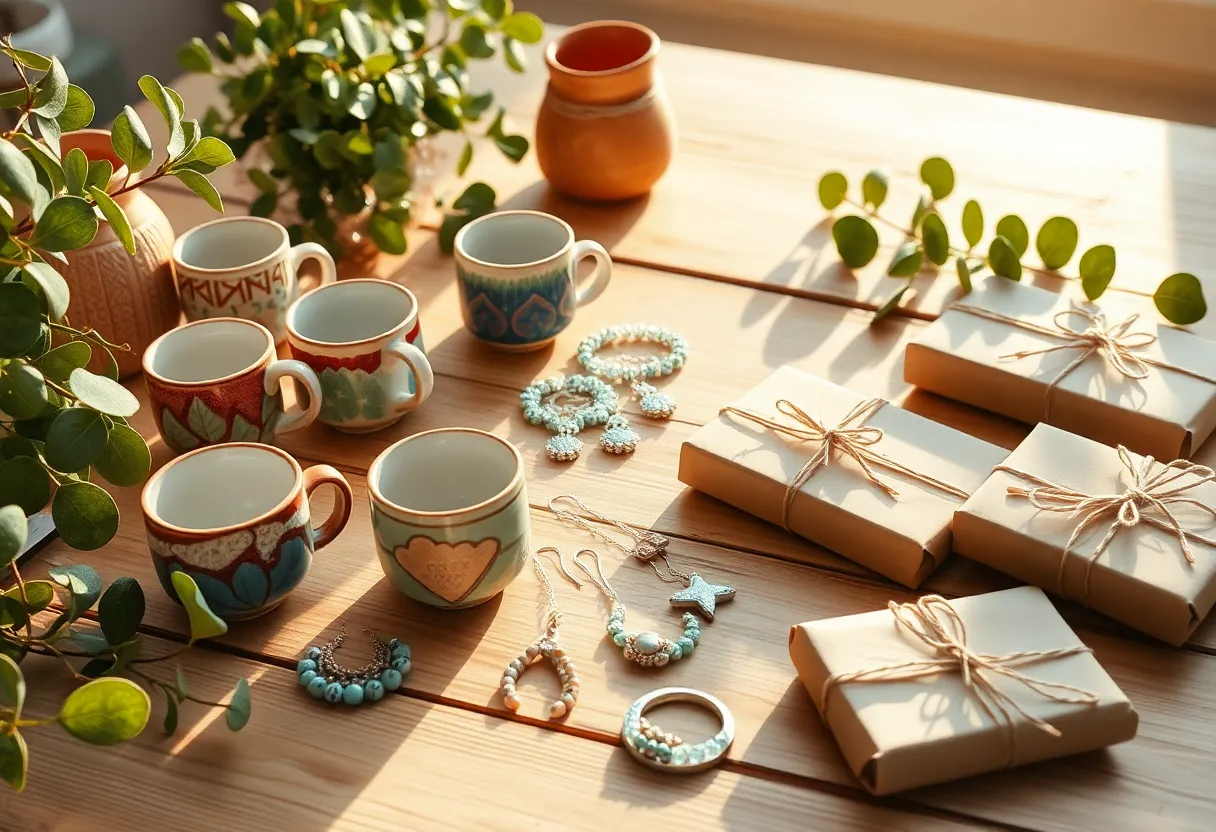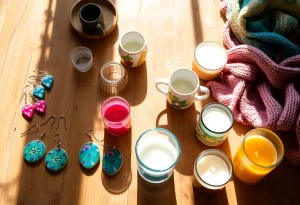Table of Contents
The Etsy Handmade Marketplace Landscape
Etsy has become the go-to platform for unique, handcrafted items, boasting over 7.5 million active sellers and 96.3 million active buyers as of 2023. This thriving marketplace has seen explosive growth, with annual gross merchandise sales reaching $13.3 billion in 2022, up from just $3.9 billion in 2018.
The appeal of handmade products on Etsy spans a wide range of categories:
- Jewelry and accessories
- Home decor and furnishings
- Art and collectibles
- Clothing and shoes
- Craft supplies
Consumer preferences have shifted dramatically towards unique, personalized items in recent years. This trend has fueled Etsy’s success, as shoppers increasingly seek out one-of-a-kind pieces that tell a story.
Here’s a quick look at some key Etsy statistics:
| Metric | Value |
|---|---|
| Average order value | $46 |
| Mobile sales percentage | 65% |
| International sales | 42% of total |
For sellers looking to thrive on Etsy, understanding these trends is crucial. Let’s explore some strategies for success in this competitive landscape.
Check out this video for essential tips on running a successful online handmade business:
As you dive into the world of Etsy selling, remember that managing multiple sales channels can be challenging. Tools like Marketplace Connect can help streamline your operations by syncing orders and inventory across platforms, letting you focus on creating amazing handmade products.
Top Selling Handmade Items on Etsy
Etsy’s a goldmine for creative folks looking to sell their handmade goods. But what’s really flying off the virtual shelves? Let’s dive into the hottest categories:
- Jewelry and accessories: From dainty necklaces to statement earrings, unique pieces are always in demand
- Home decor: Think cozy throw pillows, quirky wall art, and hand-poured candles
- Art and collectibles: Original paintings, prints, and one-of-a-kind sculptures
- Clothing and apparel: Vintage-inspired dresses, hand-knit sweaters, and graphic tees
- Personalized items: Custom pet portraits, monogrammed gifts, and bespoke stationery
These categories consistently perform well because they offer something mass-produced items can’t – that personal touch. Buyers love the story behind each piece and the connection to the maker.
This video offers some real talk for aspiring Etsy shop owners. It’s packed with practical advice to help you avoid common pitfalls and set realistic expectations.
Optimizing Your Etsy Listings for Success
Getting your items in front of potential buyers is key. Here’s how to make your listings shine:
- Craft compelling titles and descriptions
- Use high-quality product photos
- Price strategically
- Master Etsy SEO
- Provide stellar customer service
Let’s break down these strategies a bit more:
- Titles and descriptions: Use keywords buyers actually search for. Be clear and specific about what you’re selling.
- Photos: Invest in good lighting and show your items from multiple angles. Include lifestyle shots to help buyers envision using your product.
- Pricing: Research similar items to price competitively. Don’t undervalue your work, but also consider occasional sales to attract new customers.
- SEO: Use relevant tags, update your shop regularly, and encourage reviews to boost your visibility in Etsy searches.
- Customer service: Respond promptly to messages, ship on time, and go the extra mile with packaging or thank-you notes.
Remember, success on Etsy isn’t just about having great products. It’s about creating a memorable shopping experience that keeps buyers coming back.
Scaling Your Handmade Business Beyond Etsy
Once you’ve got a handle on Etsy, you might start thinking about expanding. Selling on multiple channels can help you reach more customers and boost your income. But it also comes with some challenges.
| Benefits | Challenges |
|---|---|
| Increased visibility | More complex inventory management |
| Diversified income streams | Keeping track of orders across platforms |
| Reduced reliance on a single platform | Maintaining consistent branding |
So how do you manage all this without losing your mind? That’s where tools like Marketplace Connect come in handy. It helps sync your inventory and orders across different platforms, saving you time and headaches.
Here are some tips for successful multi-channel selling:
- Start small: Add one new channel at a time
- Use consistent branding across all platforms
- Automate where possible to save time
- Keep track of which items sell best on each platform
- Adjust your strategy based on performance data
Expanding beyond Etsy can seem daunting, but with the right tools and approach, it can take your handmade business to new heights. Just remember to stay true to your craft and keep that personal touch that makes handmade items special.
Navigating Challenges in Handmade E-commerce
Handmade sellers on Etsy face unique hurdles in scaling their businesses. Let’s break down some key challenges and potential solutions:
- Production capacity vs. demand
- Quality control at scale
- Adapting to market trends
- Competition with mass-produced items
- Efficient business management
Balancing production with demand is often the biggest struggle for artisans. As orders increase, maintaining quality becomes trickier. Smart inventory management is crucial for preventing stockouts or overproduction.
Staying relevant in a fast-moving market requires constant adaptation. Successful sellers regularly:
- Research trending designs and materials
- Experiment with new product lines
- Gather and act on customer feedback
- Adjust pricing strategies seasonally
Competing with mass-produced items means highlighting what makes handmade special. Etsy sellers can emphasize customization options, tell their brand story, and showcase their craftsmanship through detailed product descriptions and behind-the-scenes content.
Technology plays a vital role in streamlining operations. Tools like Marketplace Connect can automate inventory syncing across multiple sales channels, freeing up time for creation and customer service. This efficiency is key to scaling a handmade business without sacrificing quality or personal touch.
Ultimately, success on Etsy comes down to finding the right balance between artistry and entrepreneurship. By tackling these challenges head-on and leveraging the right tools, handmade sellers can thrive in the competitive e-commerce landscape.
For more insights on growing a handmade business, check out this Etsy content marketing case study that explores effective promotion strategies.
Wrap-up
Selling handmade items on Etsy can be a rewarding journey. We’ve covered some top-selling categories like jewelry, home decor, and personalized gifts. Remember, success often comes down to finding your niche and creating products people love.
Optimizing your listings is key. Use clear photos, descriptive titles, and targeted tags. Keep an eye on trends, but stay true to your unique style. It’s a balancing act, but one that can pay off.
Don’t be afraid to branch out. Many Etsy sellers find success by expanding to other platforms. Tools like Marketplace Connect can help manage multiple channels without the headache.
Ultimately, running an Etsy shop is about constant learning and adapting. Stay curious, engage with your customers, and keep refining your craft. With persistence and the right strategies, you can turn your passion into a thriving business.
Now, let’s address some common questions about selling on Etsy in our FAQ section.
Frequently Asked Questions
How do I price my handmade items on Etsy?
Pricing handmade items can be tricky. Start by calculating your material costs and the time it takes to make each item. Add a markup for profit, typically 2.5 to 3 times your costs. Research similar items on Etsy to ensure your prices are competitive. Don’t forget to factor in Etsy fees and shipping costs. Adjust your prices as needed based on demand and feedback.
What are the best practices for shipping handmade goods?
Protect your handmade items with appropriate packaging materials like bubble wrap or tissue paper. Use sturdy boxes or padded envelopes depending on the item’s fragility. Consider offering insurance for higher-priced items. Clearly communicate shipping times and costs to customers. For international orders, research customs requirements to avoid delays. Using a tool like Marketplace Connect can help streamline your shipping process across multiple channels.
How can I protect my intellectual property on Etsy?
To protect your designs, consider watermarking your product photos. Use unique descriptions for your items to prevent copying. If you have original designs, look into copyright or trademark registration. Etsy has an Intellectual Property Policy – familiarize yourself with it and report any violations you encounter. Remember, while you can’t prevent all copying, these steps can deter most potential infringers.
What are some tips for managing customer expectations?
Clear communication is key. Provide detailed product descriptions, including materials, sizes, and care instructions. Use high-quality photos that accurately represent your items. Be upfront about processing and shipping times. Respond promptly to customer inquiries. If issues arise, address them professionally and work towards a solution. Consider using an app like Marketplace Connect to keep track of orders and ensure timely updates across all your selling channels.
How can I scale production of my handmade items?
Scaling handmade production requires careful planning. Start by streamlining your processes and identifying which tasks can be batched. Invest in tools or equipment that can speed up production without compromising quality. Consider hiring help for non-creative tasks. Explore options for outsourcing certain components while maintaining the handmade aspect. As you grow, using a multi-channel management tool can help you keep track of inventory and orders across different platforms.





